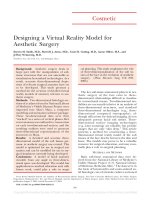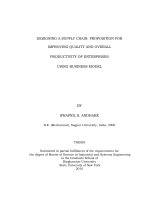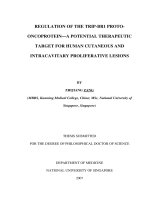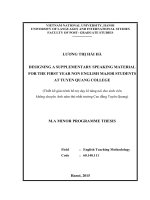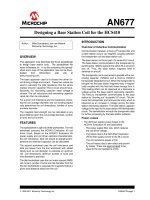- Trang chủ >>
- Sư phạm >>
- Sư phạm sử
DESIGNING A HAND GESTURE VOCABULARY FOR HUMAN - ROBOT INTERACTION APPLICATIONS
Bạn đang xem bản rút gọn của tài liệu. Xem và tải ngay bản đầy đủ của tài liệu tại đây (749.54 KB, 12 trang )
<span class="text_page_counter">Trang 2</span><div class="page_container" data-page="2">
<b>CONTENTS </b>
1. A method of convolutive blind source separation in the frequency domain
<i>Vuong Hoang Nam, Tran Hoai Linh, Nguyen Quoc Trung </i>
<i>- Hanoi University of Science and Technology </i>
1 223
2. A vision-based method for fabric defect detection
<i>Le Huy Viet, Le Thi Lan, Le Ngoc Thuy - Hanoi University of Science and Technology </i>
6 218
3. Rrelevance feedback methods for surveillance video retrieval
<i>Le Thi Lan - Hanoi University of Science and Technology </i>
11 189
4. Multiple objects tracking for visual surveillance
<i>Tran Thi Thanh Hai - Hanoi University of Science and Technology Do Nguyen Trung - Petrolimex Engineering Company – Hanoi </i>
16 196
5. Designing a hand gesture vocabulary for human-robot interaction applications
<i>Nguyen Thi Thanh Mai, Nguyen Viet Son, Tran Thi Thanh Hai </i>
<i>- Hanoi University of Science and Technology </i>
22 245
6. A novel compact microstrip dipole antenna for bluetooth/wlan mobile terminals
<i>Nguyen Khac Kiem, Dao Ngoc Chien </i>
<i>- Hanoi University of Science and Technology </i>
30 147
7. Modeling and control of single channel active magnetic bearing
<i>Nguyen Quang Dich - Hanoi University of Science and Technology Bui Vinh Dong - Technology Institute, </i>
<i> General Department of National Defence Industry Ueno Satoshi - Ritsumeikan University </i>
36
8. Modeling and simulation of single stator axial-gap self-bearing motor
<i>Vu Dang Chu, Nguyen Phu Cuong, Luu Minh Tien and Nguyen Quang Dich - Hanoi University of Science and Technology </i>
11. A PD sliding mode controller for two-wheeled self-balancing robot
<i>Nguyen Gia Minh Thao, Duong Hoai Nghia, Phan Quang An </i>
<i>- Ho Chi Minh City University of Technology </i>
60 210
12. Sliding-mode control for a single-phase active power filter
<i>Son.T.Nguyen, Thanh.V.Nguyen - Hanoi University of Science and Technology </i>
67 246
</div><span class="text_page_counter">Trang 3</span><div class="page_container" data-page="3">13. A new maximum power point tracking algorithm in PV systems using fractional estimation
<i>Phan Quoc Dzung, Nguyen Nhat Quang, Le Dinh Khoa, Nguyen Truong Dan Vu, Le Minh Phuong - Ho Chi Minh City University of Technology </i>
<i>Nguyen Anh Dung, La Minh Khanh </i>
<i>- Hanoi University of Science and Technology </i>
83 56
16. Measurement and evaluation of impulse noise on low voltage powerlines
<i>Pham Van Binh, Pham Huy Duong, Tran Mai Thanh, Nguyen Dang Ai </i>
<i>- Hanoi University of Science and Technology </i>
88 243
17. A design of digital resistance equipment for commisioning and testing
<i>Le Kim Hung - The University of Danang Vu Phan Huan - Electrical Testing Center </i>
92 186
18. A research on designing a tracking equipment for VTOL aircraft
<i>Pham Huu Duc Duc - University for Economic and Technical Industries </i>
21. A modified johnson-cook model to predict stress-strain curves at elavated temperatures
<i>Nguyen Duc Toan, Hoang Vinh Sinh, Banh Tien Long. </i>
<i>- Hanoi University of Science and Technology </i>
</div><span class="text_page_counter">Trang 4</span><div class="page_container" data-page="4">24. Effect of temperature and humidity to wear of ball linear guideway in dry friction condition
<i>Nguyen Thi Ngoc Huyen, Pham Van Hung </i>
<i>- Hanoi University of Science and Technology </i>
130 159
25. Effect of crack length and material constants on interfacial fracture criteria in mode loading
<i>mixed-Vuong Van Thanh, Do Van Truong </i>
<i>- Hanoi University of Science and Technology </i>
135 232
26. Optimization of cutting temperature in finish turning small holes on hardened X210Cr13
<i>Cao Thanh Long, Nguyen Van Du - Thai Nguyen University of Technology </i>
141 264
27. Calculation of lifetime for the beam of overhead travelling cranes under fluctuating loads
<i>Hoang Van Nam - Vietnam Maritime University </i>
<i>Trinh Dong Tinh - Hanoi University of Science and Technology </i>
146 129
28. Airfoil design optimization using genetic algorithm
<i>Nguyen Anh Thi, Dang Thai Son, Tran Thanh Tinh </i>
<i>- Ho Chi Minh City University of Technology </i>
151 177
29. Development of the non-contact optical profilometer with an autofocus laser probe
<i>Ngo Ngoc Anh </i>
<i>- Laboratory of Length Measurement Vietnam Metrology Institute (VMI) </i>
157 109
</div><span class="text_page_counter">Trang 5</span><div class="page_container" data-page="5">22
<b>DESIGNING A HAND GESTURE VOCABULARY FOR HUMAN - ROBOT INTERACTION APPLICATIONS </b>
THIẾT KẾ TẬP CỬ CHỈ CHO CÁC ỨNG DỤNG TƯƠNG TÁC NGƯỜI - ROBOT
<i><b>Nguyen Thi Thanh Mai, Nguyen Viet Son, Tran Thi Thanh Hai </b></i>
<i>Hanoi University of Science and Technology </i>
<b>ABSTRACT </b>
<i>Recently, human - machine interaction (HMI) becomes a hot research topic because of its wide applications, ranging from automatic device control to designing and development of assistant robot or even smart building at sparser scale. One of the most important questions in this research field is finding out an efficient and natural method of HMI. Among several channels of communication, hand gestures have been shown to be an intuitive and efficient mean to express an idea or to control something. In this paper, we propose a framework to study the behavior of Vietnamese in using of hand gesture in communication with robot. This study allows designing a hand gesture vocabulary for human - robot interaction (HRI) applications. In the literature, there are no works similar to ours. This makes our twofold contributions: (1) a general framework of studying and designing an interaction protocol between human and robot; (2) a basic set of hand gestures that can be used in general situation of HRI. </i>
Keywords - Hand gesture, Human robot interaction
<b>TÓM TẮT </b>
<i>Tương tác người - máy đang trở thành một lĩnh vực thu hút sự quan tâm nghiên cứu của các nhà khoa học trong và ngoài nước bởi các ứng dụng rộng rãi của nó trong điều khiển tự động thiết bị, thiết kế và phát triển robot trợ giúp hay ở quy mơ lớn hơn là tịa nhà thơng minh. Một trong những câu hỏi quan trọng đặt ra trong bài tốn tương tác người - máy là phải tìm ra một phương thức tương tác hiệu quả và tự nhiên nhất có thể. Trong số các phương thức tương tác người - máy, cử chỉ bàn tay đã được chứng minh là một phương tiện trao đổi trực quan và hiệu quả. Trong bài báo này, chúng tôi đề xuất một mơ hình nghiên cứu thói quen sử dụng cử chỉ của người Việt nam trong khi tương tác với robot. Nghiên cứu này cho phép thiết kế một tập cử chỉ tương tác cơ bản, có khả năng sử dụng trong nhiều ứng dụng tương tác người - máy. Theo như những hiểu biết của chúng tôi, các nghiên cứu trong bài báo này là hoàn toàn mới và khơng trùng với bất kỳ một cơng trình nghiên cứu khoa học trong và ngoài nước. </i>
<b>I. INTRODUCTION </b>
Robotics is currently undergoing a major change. In the past, robots have been employed in assembly lines or well structured environments. Nowadays, we can see the presence of robots in many aspects of everyday life for professional as well as personal assistant services.
To assume the communication between human - robot, many researches on HRI have been conducted. An intelligent robot requires natural interaction with human. The interaction could be performed via several perception channels like vision, speech, touch, etc. Although significant advances have been made in speech-based interface research, these interfaces will be sometimes impractical in both
noisy and quiet environment.
Gesture is an intuitive and efficient mean of communication between human and human in order to express information or to interact with environment. In HRI, hand gesture can be an ideal way that a human controls or interacts with a robot. Providing robot with the ability to understand hand gestures will improve the ease and efficiency of interaction.
To be able to interact with human through hand gesture, the robot needs to understand hand gestures. The recognition will be performed by learning examples of gestures of interest and recognize given a new gesture.
For a successful hand gesture based interaction between human and robot, a
</div><span class="text_page_counter">Trang 6</span><div class="page_container" data-page="6">23 vocabulary of hand gestures needs to be defined and a gesture based protocol of communication should be understood by both human and robot. This paper proposes a framework for designing such a vocabulary of basic hand gestures for HRI. The study and design of a gesture set, commonly used by Vietnamese in interaction with robot, helps for building applications based HRI by hand gestures. Our main contributions are: study the behaviors of Vietnamese in communicating with robot by hand gesture; define a hand gesture vocabulary that can be used for general purpose. To the best of our knowledge, there exists no similar works as ours.
The paper is organized as follows: In section II, we analyze some sets of hand gestures proposed in the literature. In section III, we propose a framework for designing a vocabulary of hand gestures then detail each step to be performed in order to obtain the results (section IV). Conclusions and future works are discussed in section V.
<b>II. RELATED WORKS ON HAND GESTURE VOCABULARY </b>
Since recent several years, a lot of researches in human - computer interaction based on hand gestures have been conducted [1,2]. In general, each work has been evaluated on a common hand gesture database then experimented with another database built by the authors themselves according to the application context. Some of databases are published for research use. But it is necessary to rebuild database for a specific application. In addition, the methodology for designing and building a hand gesture database has not been mentioned yet in all related scientific papers.
In the literature, there exists about more than ten public databases of hand gestures (including static and dynamic hand gestures) for different applications (e.g. hand sign language [3], robot controls [4]). In this paper, we do not want to do a survey on hand gesture databases in general but we focus only on hand gestures vocabulary for HRI application.
In [1], six hand gestures have been considered to control a robot: pointing, thumbing, relaxed, raised, arched, halt.
In [5], the authors used both static and dynamic gestures to control a trash-collecting robot: stop (moving arm into the right position for about 1 second), follow (wave-like motion, moving the arm up and down), pointing vertical (move the arm from a position up to a position), pointing low (starting from a position, pointing to an object on the floor, return to the initial position).
In [3], the authors tested with five types of gestures: stop, waving right, waving left, go right, go left. The data are collected from video sequences of five subjects. The subjects are led into a room with constant background and instructed how meaningful the gesture looks. They are further instructed to look at the camera and execute the movement.
In [4], a robot is controlled via five dynamic hand gestures: move forward, move forward then right, move forward then left, move backward then left, move backward then right. These hand gestures are built from one or two hands.
In [6,7], the authors presented a robot Robotinho playing the role of tour guide in museum. Arm and hand gestures are both used for communicating with tourists. The hand gestures that human interact with robots include: waving (one handed gesture), pointing (parametric, one handed gesture), thisbig (two handed gesture to indicate the size of an object), dunno (two handed gesture to express ignorance). A part from using hand gesture, body and head gesture were also considered.
We found that for each specific application, a vocabulary of hand gestures has been proposed by authors. Almost approaches build hand gesture set by predefining hand gesture set and recording videos of the users doing these gestures. Some of these gestures are common among applications (e.g. waving), some others have different meaning even the movement of the hand remains the same. This requires redefining a gesture set for a new application. In addition, this gesture set, as proposed by researchers, is imposed for human without considering if they do this in a comfortable manner or not.
In HRI, some scenarios of
</div><span class="text_page_counter">Trang 7</span><div class="page_container" data-page="7">24 communication remain the same for all applications. For example, before controlling or interacting with the robot, human needs to call the robot coming near to him/her. When human does not have anything else to command, he/she can make a signal to say goodbye or to end the interaction, etc. Therefore, we think that it should be useful to study and to design a common set of hand gestures that could be used for general context.
<b>III. DESIGNING A HAND GESTURE VOCABULARY FOR HRI </b>
<i><b>Framework of designing hand gesture vocabulary </b></i>
The designing of a vocabulary of hand gesture needs to satisfy 2 requirements:
• <i>Toward human in the interaction: The </i>
gestures should be intuitive and comfortable to perform by the human. • <i>Toward system (robot): The gestures </i>
should be distinct and recognizable by the system.
In [8], the authors proposed an method for selecting an optimal hand gesture vocabulary. However, this method is quite analytic and psychological. The authors did not indicate a study case to obtain a vocabulary.
<i>Figure 1. Framework of designing hand gesture vocabulary. </i>
We inspire the idea in this work and propose a framework to design a hand gestures vocabulary in reality (Figure 1). This framework consists of four main blocks: (1)
definition of interaction scenarios; (2) HRI observation in each scenario by camera; (3) hand gestures extraction and analysis; (4) definition of hand gestures set. In the second block, a set of people will be invited to participate into interaction with the robot without knowing that their interaction is registered (we refer to the Wizard of Oz technique - an efficient way to examine user interaction with robot). This allows obtaining the most natural HRI.
<i><b>Definition of HRI scenarios </b></i>
In order to study the behaviors of Vietnamese in communication with robot and to build a set of hand gestures, we define a series of HRI scenarios in a simulated library context. It needs to be noted that this simulated context is not a special context, so the HRI studied in this context can be used and extended to many others contexts. The scenarios must be basic and simple which allow subjects play them easily and exactly.
<i>Figure 2. An example of scenario in which a human asks the robot to know more about the abstract of a book to which his hand is pointing. The robot will answer the human by synthetic voice using Vietnamese speech synthesis system. </i>
The simulated library is a room of size 3m x 3m in which we equip some tables, chairs, bookshelves. All are similar to a reading room in the library so that the human can feel as in a real library.
To define interaction scenarios, we invent situations and assign roles to a human
</div><span class="text_page_counter">Trang 8</span><div class="page_container" data-page="8">25 and a robot. The scenario can start with a human entering into the library, learnt that there is a service robot, he looks around the room to find the robot, then calls the robot coming near to him to ask some services like looking for a book; asking to know more about the book; looking for a room; etc. During the playing, the human can do anything (by gesture or voice) to explain his demand or his attitude to the robot. Once all demands are responded/refused, the human feels (un)happy to pass the time in the library, he ends the interaction with the robot and goes outside. Figure 2 extracts a frame of a scenario in which a human is interacting with the assistant robot in the library.
Although scenarios are played in the context of a library with library specific operations, we will only study behaviors of human interacting with the robot in the most
<i>five common situations: call the robot; point to </i>
<i>something for a service; agree or disagree with the robot’s answer, finish the interaction. The </i>
library context helps the human interacting with the robot in a real situation. To summarize, five interaction scenarios will be considered: Call the robot to come.
Point to an object to know more about it. Agree with the robot.
Disagree with the robot.
Finish the interaction with the robot.
<i><b>HRI observation </b></i>
Once scenarios are defined, we start filming the scene with 3 cameras to assure that all in the scene are visible. A microphone is also used to register voice communication. In order to study the hand gesture set of Vietnamese in HRI, a multimodal corpus (video/audio) was built with twenty-two native Vietnamese peoples (eleven males and eleven females) with a mean age of 23. There are fourteen right-handers, and eight left-handers. These people have the same awareness and knowledge level.
Figure 3 illustrates the simulation interaction environment and control room. All people are asked to play two times all the defined scenarios, each at one time in the
simulation environment. To be able to obtain the natural HRI, we say to the human that we
<i>would like to test the robot’s abilities, i.e. the </i>
<i>performance of speech and gesture recognition system embedded on robot while interacting with human. He/she does not know that robot is </i>
controlled by an anonym technician in the control room. During interaction with the robot, the human is asked to not move a lot such that only hand movement is taken into account.
<i>Figure 3. Setup library simulator and control room. </i>
All twenty two peoples play two times all the defined scenarios, yielding 66 video files (22 subjects x 3 cameras). All videos files are recorded in the same format avi, sampled at 25 fps with resolution 352x280. Depending on the relative position of human w.r.t the camera pose, some hand gestures are visible in one camera field, some others do not. After selecting and editing, we have obtained 850 clips (corresponding to 459 scenarios) that only present one hand gesture per one scenario.
<i><b>Hand gesture analysis </b></i>
Until know, we have all data for gesture analysis. The analysis step should answer to the following questions:
Which gestures are used in each scenario? How are gestures characterized?
A hand gesture is defined as a sequence of movements of hand postures. In general, a gesture is composed of three phases: preparation; execution; finish. We are interested only in execution phase. We propose to analyze gestures based on hand postures and movement properties during execution phase of hand gesture as movement speed, movement amplitude; performing time of gesture.
</div><span class="text_page_counter">Trang 9</span><div class="page_container" data-page="9">26 <i>Movement speed is defined as hand speed, </i>
measured by the distance that the hand moves in a time unit (m/s).
<i><b>Movement amplitude is defined as the </b></i>
maximum distance between to hand postures centers (Figure 4) when doing the gesture.
<i>Performing time: the total time that a </i>
human does a gesture (during execution phase), counting from starting point to ending point.
To obtain the movement parameters of hand gesture during execution phase, we need to:
Detect boundaries between phases of hand gestures in order to extract only video frames at execution phase from whole video clip.
Determine 3D hand position at each frame then track the movement of the hand during execution phase, in order to compute the amplitude and the speed of hand movement.
<i>Figure 4: Movement amplitude of a hand gesture is the distance from A (starting point) to B (ending point). </i>
Currently, the boundary detection and hand tracking is done manually. Based on obtained statistic data on movement speed and movement amplitude, we found that to the speed and amplitude could be categorized into three groups:
<i>Speed: Fast (0.5m/s < F), Average (0.2m/s </i>
< M < 0.5m/s), Slow (0m/s < S < 0.2m/s). <i>Amplitude: Wide (15cm < W), Average </i>
(5cm < M < 15cm), Narrow (N < 5cm). The analyzed results show that:
We observe two interesting differences between human – human interaction and
<i>HRI: (1) in order to impress the robot, </i>
<i>when interacting with the </i> robot, Vietnamese people have trend to move the hand more than when he interacts with human; (2) the performing time for one gesture when human interacts with robot is longer because human seems to keep gestures until obtaining the robot’s response. Therefore, in almost scenarios amplitude and speed of hand movement take a mean value, not a narrow value as we expect.
For each scenario, several types of hand gestures are used in interaction with the robot.
We will now analyze in more detail the percentage that one gesture is used in each scenario. Table 1 represents two types of hand
<b>gestures “Call1 and Call2” when Vietnamese </b>
want to call robot. In the scenario definition, the scenario “call robot” is used if human want to start an interaction with robot or he/she needs the robot’s help. The analyzed results show that
<b>92% Vietnamese uses the Call1 hand gesture </b>
(open, wave, hollow of hand down) to call
<b>robot and only 8% uses the Call2 (open, wave, </b>
hollow of hand up).
<i>Table 1. Hand gestures used to call the robot. </i>
<b>Type Illustration Description Per. </b>
Call1
hand open, wave, hand hollow down
23 %
Point2
close, forefinger points, not change hand shape
<b>77 % </b>
</div><span class="text_page_counter">Trang 10</span><div class="page_container" data-page="10"><b>61 % </b>
Agree2
fingers open, but forefinger and thumb close
30 %
Agree3
fingers close, but forefinger and middle finger make the victory symbol
4%
In the second scenario (human points to an object to ask more information about it), there are also two different hand gestures that
<b>are used in which Point2 type is used more often (77%) than the first one (23%) (Point1) </b>
(see Table 2).
Table 3 represents the hand gestures used to explain an agreement with robot. In this case, four hand gesture types are carried out, in
<b>which the Agree1 and Agree2 are used more </b>
usually, with 61% and 30%, respectively, than the others.
Hand gestures of Vietnamese for explaining the disagreement with robot and finishing an interaction with robot are represented in Table 4 and Table 5. The disagreement scenario is defined in which human refuses or does not agree with the robot’s answer. The finishing scenario will be used if human wants to end the interaction with robot. One important thing needs to be noted that Vietnamese use two different types of hand gestures in each context, but almost people used one hand gesture (with the fingers open, hand
moves left, then right, then left, and shape does not change) to explain two different things
<b>(Dis1 for disagreement scenario, and Stop1 for </b>
finishing the interaction).
<i>Table 4. Hand gestures used to explain a disagreement with robot. </i>
<b>Type Illustration Description Per. </b>
Dis1
Fingers open, hand moves left, then right, then left, not change hand shape
<b>82 % </b>
Dis2
close, forefinger points down, not change hand shape
18 %
<i>Table 5. Hand gestures used to finish the interaction with robot. </i>
<b>Type Illustration Description Per. </b>
Stop1
Fingers open, hand moves left, then right, then left, not change hand shape
<b>94 % </b>
Stop2
fingers close, but forefinger and middle finger make the victory symbol
6%
In order to distinguish these two types of
<b>hand gesture (Dis1 and Stop1), we carried out </b>
some analysis on movement speed, movement amplitude, hand type (right or left), and performing time of gestures.
Table 6 shows that all most Vietnamese
<b>carry out the both hand gestures (Dis1 and Stop1) with medium and narrow moving </b>
amplitude (44% and 49%, respectively) and medium speed (61% and 58%, respectively). There are 82% and 73% human who use right hand for Dis1 and Stop1, respectively, gestures.
<i>Table 6. The analyzed results (speech, amplitude, hand type, performing time of gesture) of </i>
<i><b>Dis1 and Stop1 in two scenarios: disagreement and finish interaction. </b></i>
Fast Medium Slow Wide Medium Narrow Left Right Mean Sd.
</div>